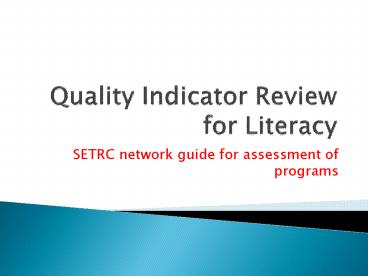Quality Indicator Review for Literacy - PowerPoint PPT Presentation
Title:
Quality Indicator Review for Literacy
Description:
Assessing quality of district program and practice in areas of literacy Determining priority need areas Prescribing and planning activities to ... (Content Areas) ... – PowerPoint PPT presentation
Number of Views:139
Avg rating:3.0/5.0
Title: Quality Indicator Review for Literacy
1
Quality Indicator Review for Literacy
- SETRC network guide for assessment of programs
2
Intended Uses
- Assessing quality of district program and
practice in areas of literacy - Determining priority need areas
- Prescribing and planning activities to change
practices and improve student outcomes
3
NYSED Literacy Work Group
- SETRC representatives from across state
- NYSED VESID representatives
- Faculty Consultant College of St. Rose
4
NYSED Literacy Study Group
- Representatives of the Task Force for Quality
Inclusive Schooling - Sarah McPherson - NYIT, Facilitator
- Lynne Burke Intl Dyslexia Assoc.
- Roberta Schnorr SUNY Oswego
- Rene Wroblewski St. Bonaventure
5
Levels of Quality Indicators for Literacy
- Early Literacy Instructional Practice
- Adolescent Literacy (Middle Level)
- Adolescent Literacy (High School)
- Specially Designed and Intensive Reading for
Students with Disabilities - Systemic Support
6
Structure of Quality Indicator Assessment and
Resource Guide
- Key Questions
- Indicator Level
- Component
- Quality Indicators in terms of there is evidence
that - Look For suggestions of evidence
- Comments/Evidence
- Annotations of definitions and hotlinks
7
Early Literacy Instructional Practice
- Component Phonemic Awareness
- Key Questions
- Is there an awareness of the progression and
development of phonemic awareness skills
students? - How does staff consistently provide explicit
systematic instruction using research-based
materials?
8
Early Literacy Instructional Practice
- Component Phonics, decoding
- Key Questions
- What research-based strategies for word
identification are consistently used? - Are students given instruction in phonics at
their level of instruction?
9
Early Literacy Instructional Practice
- Component Fluency, automatic reading of text
- Key Questions
- Is the student fluency assessed, recorded, and
monitored systematically to guide instruction at
least three times per year? - Are there instructional strategies, (ex timed
reading, repeated reading, whisper reading)
utilized to improve fluency skills?
10
Early Literacy Instructional Practice
- Component Vocabulary
- Component Reading and Listening Comprehension
- Component Written Expression
- Component Spelling and Handwriting
- Component Progress Monitoring
- Research Links attached
11
Adolescent Literacy (Middle Level)
- Component Direct, Explicit Comprehension
Instruction - Key Questions
- How does our literacy program support student as
they move from learning to read to reading to
learn? - What are the ways that teachers demonstrate and
scaffold students application of comprehension
strategies to meet the demands of challenging
text? - How do we determine which vocabulary will be
taught and what instructional strategies are used
to facilitate vocabulary development?
12
Adolescent Literacy (Middle Level)
- Component Literacy Instruction Across the
Curriculum - Key Questions
- What types of teaching aids (visual prompts,
graphic organizers, reference charts) are used to
promote understanding, mastery of content, and
generalizations? - What strategies are used to promote content area
vocabulary understanding? - How do we provide instruction that ensures
students are able to identify various structures
(text structures) of expository text?
13
Adolescent Literacy (Middle Level)
- Component Motivation and Self-directed Learning
- Component Support for Struggling Readers
- Component Intensive Writing
- Component Ongoing Formative Assessment of
Students
14
Adolescent Literacy (High School)
- Component Direct Literacy Instruction Across
Disciplines (Content Areas) - Component Reading to Learn
- Component Motivation and Self-Directed Learning
- Component Writing Embedded in Content Areas
- Component Extended Learning Opportunities
15
Specially Designed Intensive Reading
- Component Explicit and Comprehensive Instruction
- Component Assessment and Benchmarking
- Component Intensive Programming
- Component School-wide Supports
- Component Motivation and Engagement
16
Systemic Support
- Component Leadership
- Component Professional Development
- Component Summative Assessment of Student
Programs - Component Communication
- Component Universal Design for Learning
17
Charge to Study Group
- Review these guidelines
- Analyze their content
- Evaluate their relevance to teacher preparation
- Prepare final report with recommendations for the
use of these guidelines in teacher preparation
programs
18
Next Steps
- Input from Inclusion Task Force
- Critical Friends from Higher Ed Community
- Statewide Survey
- Data Analysis
- Report of Findings and Recommendations































